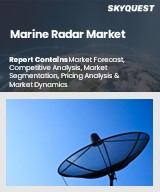
세계 선박용 레이더 시장 규모는 2023년에 53억 달러로 평가되었으며, 2024년 56억 7,000만 달러에서 2032년에는 96억 6,000만 달러로 성장하여 예측 기간(2025-2032년) 동안 CAGR 6.9%로 증가할 전망입니다.
시장 인사이트에 따르면, 해상 안전과 항해 정확도에 대한 관심이 높아지면서 상업 및 국방 분야 모두에서 선박용 레이더 시스템에 대한 수요가 크게 증가하고 있습니다. 이러한 성장은 해군 함대의 현대화와 항해 자동화 지향의 증가로 인해 더욱 가속화되고 있습니다. 고체 레이더, 다기능 디스플레이, 디지털 신호 처리 등의 발전으로 어선에서 함정까지 다양한 선박의 운용 능력이 향상되고 있습니다. 전천후 신뢰성, 장거리 탐지, 정확한 목표물 추적으로 선박용 레이더는 안전한 해상 항해에 필수적인 요소로 자리 잡고 있습니다. 또한, 레이더 기술과 GPS 및 선박자동식별장치(AIS)와의 통합은 선박 운항자의 항로 계획을 간소화하고 해상에서의 위험을 줄여 시장 확대에 기여하고 있습니다.
Global Marine Radar Market size was valued at USD 5.3 billion in 2023 and is poised to grow from USD 5.67 billion in 2024 to USD 9.66 billion by 2032, growing at a CAGR of 6.9% during the forecast period (2025-2032).
Market insights indicate a sharpening focus on maritime safety and navigational accuracy, significantly propelling the demand for marine radar systems in both commercial and defense sectors. This growth is further fueled by the modernization of naval fleets and an increasing inclination towards navigation automation. Advancements such as solid-state radar, multifunction displays, and digital signal processing are enhancing the operational capabilities across a spectrum of vessels, from fishing boats to naval ships. With their all-weather reliability, long-range detection, and accurate target tracking, marine radars are becoming essential for safe maritime navigation. The integration of radar technology with GPS and Automatic Identification Systems (AIS) is also streamlining route planning for vessel operators, thereby reducing maritime risks and contributing to market expansion.
Top-down and bottom-up approaches were used to estimate and validate the size of the Global Marine Radar market and to estimate the size of various other dependent submarkets. The research methodology used to estimate the market size includes the following details: The key players in the market were identified through secondary research, and their market shares in the respective regions were determined through primary and secondary research. This entire procedure includes the study of the annual and financial reports of the top market players and extensive interviews for key insights from industry leaders such as CEOs, VPs, directors, and marketing executives. All percentage shares split, and breakdowns were determined using secondary sources and verified through Primary sources. All possible parameters that affect the markets covered in this research study have been accounted for, viewed in extensive detail, verified through primary research, and analyzed to get the final quantitative and qualitative data.
Global Marine Radar Market Segments Analysis
Global Marine Radar Market is segmented by Type, Component, Application, End User industry and region. Based on Type, the market is segmented into X-Band Radar, S-Band Radar and Others. Based on Component, the market is segmented into Transmitters, Antennas, Receivers, Displays and Processors. Based on Application, the market is segmented into Navigation, Collision Avoidance and Surveillance & Security. Based on End User industry, the market is segmented into Commercial Vessels, Fishing Vessels, Naval & Defence, Recreational Boats and Offshore Oil & Gas. Based on region, the market is segmented into North America, Europe, Asia Pacific, Latin America and Middle East & Africa.
Driver of the Global Marine Radar Market
The growing emphasis on marine safety and collision prevention, driven by the rise in global maritime trade, has heightened the demand for vessels navigating through essential waterways, ports, and coastal regions, consequently increasing the potential for accidents. Regulatory bodies, including international and local organizations, have established requirements for the installation of radar-based navigation systems on various types of vessels, including commercial fleets, fishing boats, and passenger ships. Marine radars enhance the operational capabilities of these vessels by providing real-time detection of other nearby vessels, floating debris, and land formations, particularly in adverse weather conditions. Integrating radar with systems like ARPA (Automatic Radar Plotting Aids) and ECDIS (Electronic Chart Display and Information Systems) significantly improves threat detection and navigational precision.
Restraints in the Global Marine Radar Market
The Global Marine Radar market faces significant restraints primarily due to high costs associated with procurement, installation, and integration of advanced radar technologies. Cutting-edge systems such as solid-state, Doppler, and ARPA radars carry substantial price tags, making them less accessible for small fleet operators, fishing vessels, and recreational boats that may struggle with the additional financial burden. Beyond the initial capital investment, there are also considerable establishment expenses, including installation, calibration, and crew training, which consume both time and resources. Additionally, outdated onboard legacy systems may pose challenges in compatibility, further complicating the deployment of modern radar solutions.
Market Trends of the Global Marine Radar Market
The Global Marine Radar market is witnessing a significant shift towards integrating AI and machine learning technologies, enhancing predictive navigation capabilities and improving target classification. This trend is leading to more sophisticated adaptive signal filtering, which increases the accuracy of radar interpretation and automates various shipboard operations. Such advancements are invaluable, especially in congested and low-visibility marine environments, as they bolster the support for autonomous vessels. As industry stakeholders prioritize safety, efficiency, and operational optimization, the convergence of advanced algorithms with traditional radar systems is paving the way for a new era in maritime navigation and operational management.